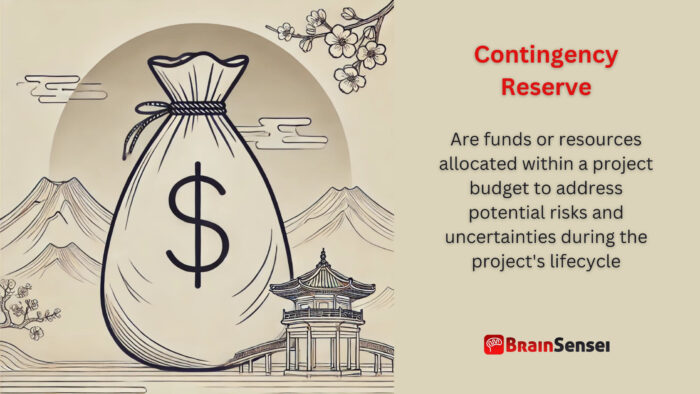
Contingency Reserve
What is a Contingency Reserve?
Contingency reserves are funds or resources allocated within a project budget to address potential risks and uncertainties during the project’s lifecycle. They are typically based on risk management assessments and are used exclusively for identified risks with known probabilities.
Key Takeaways
- Provides financial cushioning for project risks
- Derived from thorough risk analysis and planning
- Covers known risks with estimated impacts
- Ensures project continuity despite unforeseen challenges
- Differs from management reserve, which handles unknown-unknown risks
Understanding Contingency Reserve
How It Works
Project managers use risk management tools such as Monte Carlo simulations, expert judgment, and historical data to calculate the contingency reserve. The reserve is usually a percentage of the total project cost or based on cost estimates for specific risk events. It is monitored throughout the project and adjusted as necessary.
Notes
- Calculations depend on accurate risk identification and probability assessment.
- Contingency reserves should align with the project’s risk tolerance.
- Regular monitoring is essential to ensure appropriate allocation.
- Mismanagement or miscalculation can cause project cost overruns.
Related Terms
- Risk Management Plan: A document outlining how risk is identified, analyzed, and managed.
- Management Reserve: Additional funds set aside for unforeseen risks.
- Cost Baseline: The approved budget for the project, excluding management reserves.
- Risk Register: A tool to document all identified risks and associated responses.
- Monte Carlo Simulation: A technique to predict the probability of different outcomes in a project.
Examples Across Industries
Construction Industry
In a large-scale construction project, the team sets aside 10% of the total budget as a contingency reserve to address risks like weather delays, material shortages, or unforeseen site conditions. When heavy rains delay foundation work, funds from the reserve cover the cost of extended labour hours, ensuring the project stays on schedule. Additionally, during the procurement phase, suppliers experience delays delivering critical materials due to transportation strikes. The project manager uses the contingency reserve to secure alternative suppliers, preventing significant timeline disruptions. This proactive approach demonstrates how strategic reserve management helps maintain project stability.
Furthermore, as construction progresses, unexpected geological conditions arise that require specialized equipment and techniques to address. The contingency reserve covers the additional costs, ensuring work continues without delay. These scenarios highlight the importance of thorough risk assessment and prudent financial planning in construction projects.
Healthcare & Pharmaceuticals
A pharmaceutical company developing a new drug allocates contingency reserves to address potential regulatory changes or clinical trial delays. When new compliance guidelines require additional testing, the contingency reserve ensures the necessary resources are available without disrupting the timeline. For example, during Phase III clinical trials, regulators mandate additional tests to evaluate drug interactions with other common medications. The contingency reserve covers the costs of these tests, laboratory resources, and additional personnel.
In another instance, supply chain disruptions result in delayed delivery of critical components for drug production. The contingency reserve funds expedited shipping and alternative suppliers, minimizing the project’s delay. This proactive use of reserves showcases the importance of allocating sufficient funds to address complex and evolving regulatory environments in the pharmaceutical industry.
Telecommunications Sector
A telecommunications company installing a new fibre-optic network uses contingency reserves to manage potential risks, such as equipment malfunctions or unexpected infrastructure obstacles. When a critical piece of equipment fails during installation, the reserve covers the cost of expedited replacements, preventing costly delays. Additionally, the project team encounters difficulties obtaining necessary permits due to unexpected regulatory changes. They utilized the contingency reserve to hire legal experts who assist with expedited approvals.
As the project nears completion, weather-related disruptions affect the scheduled work. The contingency reserve funds additional labour shifts and weatherproofing measures to ensure the project finishes on time. These examples illustrate how contingency reserves can address technical and administrative challenges in infrastructure projects.
Use Cases of Contingency Reserve
United States (Construction)
A construction firm in Texas is building a commercial complex and using contingency reserves to cover unexpected geological issues during foundation excavation. With the funds available, the project remains on schedule despite the unforeseen challenges. During the excavation phase, workers encountered an unexpected limestone layer that required specialized equipment and extended labour hours. The contingency reserve covered the additional costs, preventing the foundation’s completion delays.
Later in the project, a supplier delay threatened to postpone the installation of critical structural components. The project manager allocated contingency funds to expedite shipments from an alternative supplier, maintaining the project’s timeline. This case illustrates how contingency reserves help manage risks and keep projects on track.
Germany (Renewable Energy)
A wind farm project in Germany uses contingency reserves to address potential delivery delays of turbine components. When supplier delays occur, the reserve funds expedite shipping options, keeping the project on track. In the early stages, unexpected regulatory changes required modifications to the turbine designs. The contingency reserve covered the costs of redesign and re-approval processes.
Additionally, adverse weather conditions threatened to delay the installation of turbines. The project team utilized contingency funds to deploy weather-resistant equipment and implement flexible scheduling for construction crews. This approach minimized weather-related disruptions and ensured timely project completion.
India (Infrastructure)
A metro rail project in India allocates contingency reserves for possible labour strikes or material price fluctuations—the reserve funds temporary labour replacements when a short-term strike occurs, minimizing project disruption. During construction, fluctuating steel prices posed a significant risk to the budget. The contingency reserve secured bulk purchases at fixed rates, stabilizing costs.
Furthermore, discovering uncharted underground utilities required adjustments to the rail’s design. The contingency funds covered the cost of additional surveys, design modifications, and updated permits. This example demonstrates how contingency reserves address diverse risks and support efficient project execution.
Best Practices
Managing contingency reserves effectively is essential for maintaining project stability and ensuring risk readiness. Here are some best practices that span the lifecycle of a project and provide a solid foundation for managing these reserves successfully:
Conduct Comprehensive Risk Assessments
Regular risk assessments help identify potential threats that may impact the project. Techniques like SWOT analysis, the Delphi method, and Monte Carlo simulations provide insights into potential risks and their likely impacts. Engaging diverse team members in risk workshops fosters varied perspectives and more accurate risk identification.
Adopt Industry-Standard Calculation Methods
Utilizing methods like Expected Monetary Value (EMV), sensitivity analysis, and decision tree analysis ensures consistency and precision in reserve estimation. Each technique offers insights into probable outcomes, helping stakeholders understand the reasoning behind the allocated reserve.
Maintain Transparency with Stakeholders
Transparency is key to building trust among project stakeholders. Maintaining open communication about contingency reserves’ existence, purpose, and use can prevent misunderstandings. Using dashboards and reports for real-time updates on reserve utilization enhances visibility.
Integrate Reserves into the Project Budget
Integrating contingency reserves within the overall project budget helps prevent confusion and ensures that the funds are readily accessible when needed. This integration also facilitates better financial planning and control.
Implement Regular Monitoring and Adjustments
As projects evolve, new risks may emerge, while others may dissipate. Regularly reviewing and adjusting the contingency reserve ensures the funds align with the project’s risk profile. Software tools for automated tracking help streamline this process.
Document Decisions and Lessons Learned
Maintaining detailed records of reserve usage decisions provides valuable insights for future projects. Documenting lessons learned helps refine risk management practices and improve the accuracy of future reserve estimations.
Develop Clear Utilization Guidelines
Establishing clear guidelines for when and how to use contingency reserves ensures consistency and prevents misuse. Including these guidelines in the project risk management plan provides clarity for all team members.
Foster a Risk-Aware Culture
Promoting a culture that prioritizes risk awareness encourages proactive identification and mitigation of potential issues. Training sessions, workshops, and simulations help instill this mindset across the organization.
Common Mistakes and Issues
Mistakes in managing contingency reserves can lead to significant project setbacks. Understanding and learning how to avoid these pitfalls is essential for project success. Below are common mistakes and issues associated with contingency reserve management and practical insights to prevent them.
Inadequate Risk Identification and Analysis
A fundamental mistake is failing to identify and analyze potential project risks comprehensively. When risks are overlooked or underestimated, contingency reserves may be insufficient to address unexpected challenges. For instance, an unforeseen geological condition in a large infrastructure project caused significant delays and costs, and the project team failed to account for it during the planning phase.
Prevention
- Conduct thorough risk assessments using tools like SWOT analysis, Monte Carlo simulations, and expert interviews.
- Involve cross-functional teams in risk identification sessions to capture diverse perspectives.
- Maintain a dynamic risk register that is updated regularly as new risks emerge.
Overestimating or Underestimating Reserve Requirements
Misjudging the required reserve amount is a common issue. Overestimating leads to unnecessary cost buffers, which could have been allocated elsewhere, while underestimating results in insufficient funds during critical stages. For example, a software development project was delayed when the contingency reserve for integration testing proved inadequate. The team had to request additional funds, delaying project completion.
Prevention
- Use historical project data and industry benchmarks to inform reserve estimates.
- Apply quantitative techniques like Expected Monetary Value (EMV) to calculate reserves based on risk probability and impact.
- Regularly review and adjust reserves as new information becomes available.
Lack of Transparency and Communication
Poor communication regarding contingency reserve policies can cause confusion and mistrust among stakeholders. In a construction project, the finance team was unaware of the contingency reserve’s purpose and refused to release funds when needed, causing avoidable delays.
Prevention
- Document and communicate reserve policies clearly to all stakeholders.
- Utilize dashboards and reports for real-time updates on reserve utilization.
- Establish protocols for accessing and using contingency reserves, ensuring everyone understands the process.
Misuse of the Contingency
Sometimes, projects improperly allocate contingency reserves to cover non-risk-related expenses, depleting funds for legitimate risks. For instance, a project manager used reserve funds to purchase additional office supplies, leaving the budget short when an actual risk materialized.
Prevention
- Set strict guidelines on the acceptable use of contingency reserves.
- Monitor reserve usage closely with financial tracking tools.
- Train project managers on the importance and intended use of contingency reserves.
Failure to Monitor and Update Reserves
Contingency reserves should evolve with the project’s progress and changing risk landscape. A renewable energy project experienced cost overruns when new risks emerged during construction, but the reserve remained unchanged from the initial estimate.
Prevention
- Schedule periodic risk reviews to reassess reserve adequacy.
- Utilize software tools for continuous risk monitoring and reserve adjustment.
- Encourage a proactive risk management culture that adapts to project developments.
Ignoring Lessons Learned
Projects that do not document and analyze mistakes miss opportunities for improvement. For example, a pharmaceutical company repeated the same budgeting error across multiple trials because lessons from previous projects were not recorded or shared.
Prevention
- Create a centralized knowledge repository for lessons learned.
- Conduct post-mortem reviews to analyze reserve usage and identify improvements.
- Share findings across departments to build collective risk management knowledge.
Case Study: Software Development Project
In a complex software integration project, the manager allocated a contingency reserve based on optimistic estimates, assuming minimal integration issues. Midway, the team encountered significant compatibility problems that required additional resources and expert consultations. The insufficient contingency reserve led to delays, increased costs, and missed deadlines.
Lessons Learned
- Conservative reserve estimation is advisable for high-risk components.
- Continuous monitoring and iterative adjustments can mitigate emerging risks.
- Cross-disciplinary collaboration helps identify integration challenges early.
Effective contingency reserve management requires diligent planning, continuous monitoring, and proactive adjustments. By understanding common mistakes and implementing preventive measures, project teams can enhance their resilience against uncertainties, ensuring successful project outcomes.
Frequently Asked Questions (FAQs)
How is the contingency reserve calculated?
Project managers calculate contingency reserves using quantitative risk analysis techniques, such as Expected Monetary Value (EMV), which multiplies the probability of risk occurrence by the potential impact.
Is contingency reserve part of the project budget?
Yes, contingency reserves are included within the cost baseline and comprise the overall project budget.
How does contingency reserve differ from management reserve?
Contingency reserves address known risks with calculated probabilities, whereas management reserves handle unforeseen risks that cannot be predicted.
Can contingency reserves be reallocated?
If the identified risks do not materialize, contingency reserves can be reallocated or released based on project needs.
Who decides when to use contingency reserves?
Project managers, often in consultation with risk management teams, decide when and how to utilize contingency reserves.
Additional Resources
Preparing for a PMI certification?
- Exam Prep Courses: PMP®, CAPM®, and PMI-ACP®
- Exam Simulators: PMP®, CAPM®, PMI-ACP®, PMI-PBA®, PMI-RMP®, PMI-SP®, PgMP®, and PfMP®
- Professional Development Units (PDUs): 15, 30, and 60 PDU Bundles



